#early Hellenistic Era
Explore tagged Tumblr posts
Note
Dr. Reames, I was wondering if you were familiar with the Live Science piece discussing the Herculaneum papyrus being an Alexander book and quoting Richard Janko. If so, any thoughts on it? Or any speculation at this point? Tumblr won't let me quote the link to the actual article but I've posted the link in my own blog. Thanks.
Yes, I've read a couple media articles about this. It's exciting! I really hope we can make out more. That period immediately after Alexander's death is problematic, especially in timing (we have a "higher" and "lower" chronology), as we don't have a lot of surviving sources. Diodoros Book 18 (on the Successors) is fragmentary and there's just not a lot else.
So it would be fantastic if we could recover another source. Methods of reading damaged documents have improved enormously. I have high hopes, although no doubt parts of it are simply broken past recovery.
Should probably add a link to what we're talking about:
Live Science article
13 notes
·
View notes
Note
What's your PhD about?
I haven't started it yet cause I'm looking for funding first so this might change (also I've altered the PhD propossal depending on the professor that would be my supervisor) but basically I want to study the Muses through the lens of Cultural Memory.
The ideal thing would be to study them and their evolution throughout ancient Greece, but that's impossible so for example my current PhD director suggested I should focus on the Archaic Era (also the Dark Ages, so around the 10th to 6th centuries BCE more or less). I am very interested in the relationship between identity, literacy, and religiosity, so the Muses are perfect for it, as they were used by the Greeks as a sort of fact-check for aoidoi and poets, which were the preservers of Cultural Memory.
Most stuff that's been written about the Muses has always been very philological and especially related to the 'invocation of the Muses' so prevalent in Greek literature. I want to open the scope to new angles, something never done before, and I have experience working with Cultural Memory from my Master's Thesis, so I thought it would be a cool approach :) It's gonna be much more theoretical than you would expect, but I love that sorta thing. Also it's impossible to separate the Muses from literacy so I'll be looking at written sources for sure, my good pal Hesiod (whom my Undergrad Thesis was about) will occupy a good chunk of the research I'm afraid.
So yeah, that's it. This won't happen if I don't get funding tho, so I could just never write this Ph.D. Who knows.
#ask#sorry for the lengthy answer anon i've had to write so many phd proposals in the past few months i just go with the autopilot#i hope it's comprehensive enough. and please feel free to ask more questions!! i am very passionate about this so i would love#to answer more stuff like this :)#i'm currently researching my second master's thesis btw#it's gonna be about the cult of the muses in thespiai#so a bit of context#the heliconian muses (which are like the 'canon' muses; the ones described by hesiod) 'originated' around helicon mt#this is a real place in boeotia greece#the valley of this mountain is the valley of the muses. hesiod lived right there#in ascra.#ascra at some point was conquered by the city of thespiai. and it was part of it for the rest of ancient greece#(this happened very early on btw. like probably 8th or 7th century)#there was a sanctuary of the muses built in the vale#and this agonic competition (like a music festival) took place there called mouseia#it became incredibly important#but the thing is. this all happened in the hellenistic era (so 2nd - 1st centuries BCE)#there is barely any evidence of anything muses related in thespiai before that#noticeably it was in the hellenistic era when hesiod really became famous#so i want to study the evolution of the cult of the muses in thespiai; the evidence (or lack thereof) for it; and its instrumentalization#by thespiai#i'll mostly do it through epigraphy cause 1) it's the source i'm most comfortable with and 2) there's not really much else#i'll also sprinkle in cultural memory and some heavy theoretical stuff in there just for fun#so yeah i'm having fun with it :) hopefully i'll finish it by october!
8 notes
·
View notes
Text








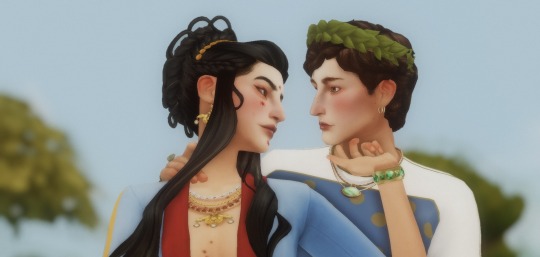

previous ➸ next | beginning
Oh dear, young, idiotic King Nikomachos II, son of Demosthenes of Mycenae. Or, rather some smaller provincial kingdom of north-western Lakonia, to rather generalise, from which his great Eurypontid house needed to expel him; with a reign that proves as just as trivial and hedonistic as he. Powdered in rouge as an effeminate leukochrōs, Nikomachos, deformed and ill-bred, possibly a bastard of helot whisper and beheld among five elder sisters, the boy’s kingship was a jest among all the Peloponnese behind closed doors. Yet, in his Kastro Koiláda Chalkou, the scrutiny of the Ekkelisa could not reach him and his whore-bride to be, Eurynome, for the luxury and the splendour of Dionysos and Demeter’s sweet ecstasy were irresistibly intoxicating. For who has time for leading trade routes and waring territory when the pig has only just been carved?
so, what is this? i actually am not sure yet, will it be gameplay, will it be story? we will find out at some point, but i just desperately wanted to play with the late bronze age because as an ancient history and linguistics major, it is my duty. i have always been deeply in love with my hellenistic greco-roman history and thought it would be quite fun to delve into a period i am not as familiar with with the Mycenaeans, to see what i can learn. also considering the beautifully accurate amount of cc clothing for this era, particularly by @clepysdra which i feel the classical age is lacking in among historical cc compared to the bronze age. BUT in speaking of accuracy, those that noticed i referenced the Eurypontid house of the diarchic Spartans, the Ekkelisa and the names of my sims themselves, for the sake of my own enjoyment, i WILL be snatching names for funsies with no relation to their historical origin, but i do want to try my best to make this accurate to Mycenaean culture/dress/relgion, etc. but i am still learning about this fascinating time. i also want to give the BIGGEST praise and thank you to @kyriat-sims for her absolutely beautiful early civilisation save that she’s created, as well as the build featured in this post (which you can find HERE and HERE) as although i tweaked the interior to my manic over-cluttered taste, the castle shell itself is done by her and it’s so brilliant <3
#cardamon#the delusions have got to me again#now you may have noticed my ultimate decades challenge has disappeared#and i don’t know what to tell ya#sometimes i just get struck with new inspiration and the adhd tells me to make it happen now#so now we’re here#hopefully i can make something out of it#:D#ts4#the sims 4#ts4 historical#ts4 legacy#ts4 early civilisation#ts4 greece#eurynome#nikomachos#ts4 ancient greek#leukochrōs#the ancient greek feminisation of the male face by painting it white
89 notes
·
View notes
Text
Is Italian Witchcraft... just Hellenism/Roman Religion?

In the past people asked me why didn't I "just deal with Roman Deities, being Italian".
At first I did not understand how people could not understand that Witchcraft could be a religion, especially Italian Witchcraft, having "new Deities."
The more time passed, however, the more I realized that often the "new Deities" are considered "part" of the pantheon of which they are remnants.
For example, Perchta and Holda are considered part of the Germanic pantheon by many pagans, despite the fact that they are figures who emerged and were present when the Christianization of those peoples had been completed by then.
Similarly, a Hellenist guy recently ranted about the fact that until the early 1800s "saint Demeter" was still worshipped in Eleusis, and he considered this pagan remain in Christian times as part of Hellenism.
Come to think of it, even Leland himself had called his book "Etruscan Roman Remains."
I can understand that Diana and Lucifer might fit in smearily, for example, if Lucifer is understood as an epithet of Apollo (who in fact has Phosphoros as one of his official epithets in the Orphic Hymns themselves)...
But my doubt is, if so, is Madonna Horiente to be considered a Roman goddess?
Is Aradia part of the Roman pantheon?
Are those who worship the Lady of the Game neo-Druids, being in northern Italy, or Hellenists/Religio Romana practitioners, considering that this Deity is now seen as a Roman and now as a Celtic remnant?
Certainly I have a connection with Religio Romana and Hellenism, because of how much of my pantheon I share with them.
From my own personal point of view, I also call myself "Hellenist" (in the sense established by Emperor Julian, thus including the Roman pantheon too).
But as an official classification, regardless of my preferences, I still have doubts about whether Italian Pagan remnants are Hellenism or Religio Romana rather than "Italian Traditional Witchcraft"/"[Region of Italy] Traditional Witchcraft."
It is possible perhaps to divide between:
- Hellenists who also include Greek and/or Italian pagan remnants in the Christian era (or Heathens who also include pagan remnants in the Christian era found in Germanic countries), and
- those who only worship pagan remnants (which I would ONLY call Traditional Witches).
What do you guys think?

#paganism#trad craft#tradcraft#reconstructionist traditional witchcraft#traditional witchcraft#folkloric witchcraft#hellenism#hellenic polytheism#hellenic pagan#religio romana#roman paganism#roman polytheism#stregheria#stregoneria italiana#italian traditional witchcraft#italian witchcraft
27 notes
·
View notes
Note
why pjo's portrayal of the greek gods is fucked up and how it's affected perceptions surrounding ancient Greece.
*breaks down the door to your inbox with an axe*
start talking now oh my god I want to hear your hot take so bad. I've been interested in religious studies (primarily the Hellenistic and early Roman religious atmosphere (of course acknowledging that the word religion is post-Enlightenment and conceives of supernatural belief as a subjective individual belief, which is inconsistent with how supernatural matters were dealt with in the Ancient world) and how they intersect with early Christianity and proto-Christianity) and I've been fascinated with the Greek gods and I need your hot take on why their portrayal is wrong and leads to incorrect assumptions about Ancient Greece.
oh you bet your bottom dollar i will talk about this. true to the post from which this originated, i will prep no material and all this is off the top of my head so don't quote me!
If you follow my Greek mythology sideblog, you'll know i am unequivocally a Zeus defender. Now I can make a million posts about Zeus alone but I will take a more holistic approach on the gods in general and the perception of Ancient Greece.
The West has been obsessed with Ancient Greece for centuries: the culture, philosophy, history, mythology, mathematical and scientific advancements, and much more. Now it's one thing to take interest in a country's history or a historical era; it is completely another to claim it as your own and make it an ideal state of life to achieve, because if you know literally anything about Ancient Greece, it was anything but. What I'm trying to say here is that Ancient Greek culture has been commodified, glorified, rewritten, and reclaimed by the West when it was never theirs to do so. I've often seen this sentiment expressed by Greeks about their homeland: "The history comes first, the people second." I think a prime modern example of this mindset was when same-sex marriage was legalised in Greece, which was a huge step forward for an Orthodox country with an extensive history of homophobia, but people outside of Greece began making jokes of Greece "returning to their own values" (referring to Ancient Greek practices of pederasty which is hugely problematic and not at all representative of any gay rights if you know what it entails) and people excited to "finally hold lesbian weddings in Lesbos" (signifying the West's perception of Greece as simply a tourist hotspot and not a country with an intricate history and culture). In short, Greece is already unfairly used for the West's agenda of glorification and attempts to build itself a culture that frankly isn't theirs at all.
Now, how does this involve pjo? A lot, my friends, a fucking lot. The publication and popularity of the Percy Jackson series has simply exacerbated all the aforementioned issues in this post. First off, the worldbuilding on which The Lightning Thief relied and the rest of the series ultimately holds is that "Olympus moves with the centre of Western power", which is just. Wow. There are a million things wrong with this concept that would need its own post, so I recommend this article called The Whitening Thief that essentially explains the white supremacy of it all. If you do not want to read the full article, the main premise is that the Percy Jackson series equates Westernism with civilisation and that without it there was "chaos and darkness", which as Paule describes it, is "sipping at a pretty racist cocktail".
note: I have realised how aggressively off-topic this is to the original statement I made, I'm getting there, I promise (although I did warn you it was something I could talk on for hours with little material)
Let's finally delve into the depiction of Greek gods in Percy Jackson. I'll actually start on a bit of a positive note that apart from the weird (for lack of a better term) comparisons of Hades to Adolf Hitler, the original Percy Jackson and the Olympians had some okay characterisation of the gods (I have some reservations about the goddesses on which I will elaborate later). They're prideful and neglectful parents (the myths actually contradict that latter part but I digress) but each with their own complexities and concerns. To use Zeus as an example because he's actually the god who falls short the most in terms of consistent characterisation in my opinion, he lets Percy live in TLT "for the sake of peace in [his] family", indicating a care and sense of duty for Olympus and for his fellow gods, and while he lets his pride and paranoia get the better of him at times, he is shown as a serious authority figure and someone who's trying to keep his realm together, and such characteristics wouldn't be too far off from his mythical counterpart.
But as the series progresses, either Rick got lazy or he attempted to further capitalise his work to make it more palpable, he turns the gods into caricatures by excessively inflating one characteristic they may have into their entire personalities. Returning to Zeus, his paranoia is amplified to an absurd extent that one can simply not fathom why the gods would be the better option than the Titans. As I said initially, he had bouts of paranoia that would be almost normal for someone with such a powerful position, but this is completely derailing any connection with his mythological counterpart, he may as well be an OC with the same name and title as him. To use other gods as an example because I promised a holistic approach and I have seemed to only talk about Zeus (sorry!), the writing of the goddesses Hera, Artemis, Aphrodite, and Athena is simply misogynistic. I'm sorry, there is no other way I can find myself to describe it. Typically feminine goddesses Hera and Aphrodite are extremely demonised and condemned for their flaky and vain attitude; Hera is the evil stepmother archetype and Aphrodite ultimately becomes weak and useless. The "virgin" (quotations referring to Athena) goddesses Artemis and Athena also don't seem to extend past superficial, unoriginal characteristics like being a vehement man-hater who kicked out two sapphics from the Hunt and a goddess who Rick stops at nothing to render her a horrible parent and person (using the Roman myth of Medusa, exaggerating her prideful nature, etc) respectively. And you cannot tell me they're not misogynistic portrayals because just a few minutes on pjo tiktok will show you just how many times Hera is referred to as a bitch (keep my wife's name out of your fucking mouth!!). Then there is TOA and COTG, which makes me want to cry just thinking about Zeus' portrayal there (yes we're going back there). The god who was consistently thought of as a gracious, protective saviour of the people in Ancient Greece (full list of epithets of Zeus, read at your leisure) is an abusive autocratic tyrant?
To go back onto the topic, how do Riordan's works affect the overall perception of Ancient Greece? Well, as I said before, it contributes to the white supremacist view of Ancient Greece as the epitome of civilisation and the glorification of the era, but it also turns Ancient Greece into a fandom to an extreme extent. Now, obviously, I'm not talking about people with a healthy obsession with Ancient Greek history and Mythology (myself included) who like to engage in content about it. I'm talking about people who claim Ancient Greece as an extension of Western, mostly American culture, and ultimately engage in a form of cultural appropriation that strips Greeks of their own history and narrative. This includes writing 'feminist' retellings of Greek myths, taking Riordan's (inaccurate) readings of the mythology as indisputable fact, and removing the myths from their historical and cultural context. People forget that much of these myths were stories written for entertainment and take them as a sort of Hellenic Bible (which delves into the Christianisation of Greek Mythology but that's a whole other post). In short, Westerners think they can do whatever the fuck they want with Greek mythology and Greek gods because they think it's theirs with which to play around, ultimately ignoring the country, history, and the culture from which they actually originate, and it's thanks to Rick Riordan that this attitude has blown up to an insane extent.
*sighs* Thank you for coming to my TedTalk and I seriously admire you if you made it this far.
#diya answers#i wrote all this instead of doing the pile of homework i have so yeah enjoy#sunset-telepath#rr crit
70 notes
·
View notes
Text
2025 Book Review #74 – The Glory of the Empire: A Novel, A History by Jean d’Ormesson

I found this, frankly, leafing through my bookshelf looking for a final book to read this year. I have a chunk of my bookshelf devoted to history books from university I never did more than skim through the introduction of, and at a glance at the cover and name I’d always assumed it was one of those. As it is actually a work of rather literary alternate history written by a French guy in 1971 I have literally no idea how I ever came into possession of it. However it happened this is, sadly one of those cases where it’s a book that’s almost written specifically for me, and is instead just a few degrees off and entirely intolerable.
The book is a history, though one of an empire that never existed. It arose and spread across the world in a vague era I can only really describe as ‘Xena Warrior Princess times’, shaping the history and cultures of everything that has followed. The book is written in the style of one of the more self-assured and grandiloquent monographs of the era, full to bursting with references to the historiography and the cultural memory of the events being described, and symbolic and psychoanaltyical perspectives on the people involved. The the book charts the vaguely Hellenistic, vaguely Byzantine empire’s rise, fall, and greater rise still across the centuries, mainly through the biographies of its three great unifiers.
Deciding what I think of this has been difficult because, as an artistic project it is a complete sense. As a matter of form it mimics (and exaggerates) the histories its based on near perfectly, and its themes are clearly are woven through the entirety of the text. Great care has clearly been taken with everything from the fake bibliography to all the ‘preserved fragments’ of poetry and the quotes put in famous figures mouths.
Perfectly executed it is just, awkwardly, a project I find somewhere between gratingly unenjoyable and actively loathsome. As a novella, it would have been a really interesting experiment in form – at 450 it’s a painful struggle. It does at least make for an interesting reading experience, if not one I can exactly recommend.
The best way that I can sum up the book is all the most irritating and tiresome tropes of old antiquarian histories, exulting in liberation from any obligation to those tedious and limiting facts and existing traditions which might restrain them. The result feels less like any sequence of events which might possibly have occurred and more like the lore of a rather generic fantasy setting.
In terms of style, the narrator drones. He bombards you into one lengthy and enumerated list of no consequence after another. He goes on long digressions about the fun anecdote leading to the discovery of a source that were presumably entertaining to him. He gestures towards the significant contributions of other schools of history as a polite aside and then ignores them entirely. He just, generally, reads like someone getting paid by the word.
As for tropes – look, this was published in the early ‘70s, a certain level of casual racism is kind of just the price of admission. But this really was just distractingly Orientalist. The constant presence of the savage barbarian hordes filling the Eurasian steppe, knowing nothing but war and bloodshed and always on the verge of overwhelming and destroying civilization, is presented as a simple and enduring fact of history. The essential and unified nature of ‘Eastern mysticism’ plays a key part in the plot. In this history stretching across all of Eurasia, Africa south of Egypt and Carthage simply does not exist except as a source of slaves. And so on – I suppose I really shouldn’t be surprised by this, any more than the occasional mentions of (male, of course) homosexuality exclusively as a symptom of decadent and effeminate urban decline, or the fact that there are (barely, and being generous) a grand total of two women with any significant at all beyond being a romantic prospect or mother of someone who really mattered.
In structure and thesis it is the greatest of Great Man histories, full of the world being shaped and remade by the epoch-defining virtues and faults of a small handful of epoch-defining emperors, ministers and saints who sweep away all before them. Logistics simply do not exist, political organization and grand strategies are organized across a span of continents without issue, every conflict is preordained by which side the Great Man of the moment happens to be on. Whole chapters of the book are devoted to giving the personal biography of the Emperor Alexius before his rise to power – chapters which feel less like reading the biography of person who might actually have existed and more like aan overlong Wikipedia article summarizing the exploits of the hero in some decades-old serial franchise. His adventures are all-but-explicitly compared to the Alexandrian Romance as a genre, but without any of the cultural context or comparisons over time that make that inspiration actually interesting.
All to say that yes, it is an excellent reproduction of a particular style of old history – and I am wholly agnostic on whether everything I just complained about is a flaw of the author or a testament to the skill of their imitation. It’s just not a kind I’ve ever found anything but tedious to read, and without the redeeming virtue of having any sort of reality to peer at through the fantasy, or a fantasy that was particularly compelling to read about on its own merits. Or I suppose some readers may find all the attributions of famous sayings, events and fables to the book’s characters intriguing or charming? Given the density and blatantness of them I just quickly found it eye-roll inducing. And without that colour the history has less drama or tension to it than the lore of your average Dungeons and Dragons setting. And as personal drama and character work – well, remarkably few plots are improved by being told in the form of a meandering essay that spends more time hammering you in the head with what glorious, world-historical love stories they are than actually telling you the story.
The books themes are quite explicit and all but didactic – about the relationship between history and fiction, and how every historian is creating their own reality and imposing their narrative on a loose scaffolding on fact and memory. Which is an entirely fair theme for a work of fiction, and I assume not quite so tired a one back in 1971. But my god are both popular and academic histories these days better about it. I have in the past joked about how ‘well isn’t that kind of reductive/oversimplifying’ has been every historian of the last two generation’s default response to any sort of theorizing or edifice-building of any kind, but this book has done an excellent job reminding me how preferable it is to the sweeping, mytheopic alternative.
Anyway yeah, intellectually interesting enough that it might have been
#book review#the glory of the empire#Jean d’Ormesson#literatre#french lit#20th century#in translation
14 notes
·
View notes
Text
2,300-Year-Old Gold Ring Found in City of David
Israel Antiquities Authority says ‘emotionally moving find’ likely belonged to a boy or girl.
Archaeologists have discovered a 2,300-year-old ancient gold ring set with a precious stone in the City of David Jerusalem, which was reportedly made for and worn by a young child who resided there during the Hellenistic period.
The excavations were carried out jointly between the Israel Antiquities Authority (IAA) and Tel Aviv University (TAU) as part of the Jerusalem Walls National Park project, with the support of the Elad Foundation.
“It is an unusual and deeply moving find; not one that we discover every day,” the archaeological team told the Jerusalem Post. The red precious stone was apparently a garnet, and the gold is a refined material that was very well-preserved. Since its last use over two millennia ago, the ring hasn’t accumulated rust or weathering.
The gold ring was recently uncovered by Tehiya Gangate, a City of David archaeologist and member of the excavation team. She was sifting earth through a screen when something glittery caught her eye,


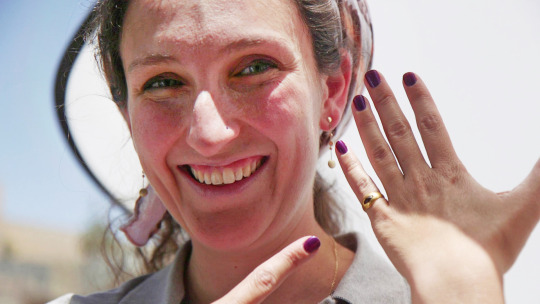
“I immediately yelled, ‘I found a ring, I found a ring!’ Within seconds, everyone gathered around me, and there was great excitement. This is an emotionally moving find. I always wanted to find gold jewelry, and I am very happy this dream came true – literally a week before I went on maternity leave,” she told the Jerusalem Post.
“The ring is very small. It might fit a woman’s pinkie or a young girl’s or boy’s finger,” IAA excavation directors Dr Yiftah Shalev and Riki Zalut Har-tov said.
Dr Marion Zindel added that the ring was made by hammering thin pre-cut gold leaves on a metal ring base. Aesthetically, it is characteristic of the common fashion of the Persian and early Hellenistic periods, dating from the late fourth to early third century BC and onwards. During that era, people started to have a preference for gold with set stones rather than decorated gold.
By Matthew Norman.
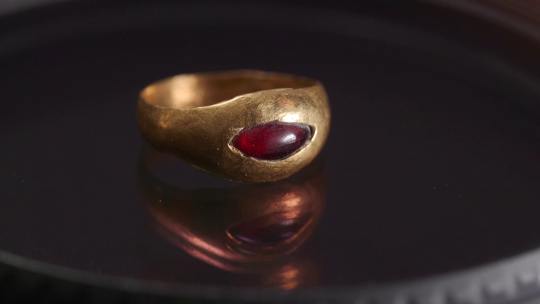
#2300-Year-Old Gold Ring Found in City of David#City of David#Jerusalem#israel#Hellenistic period#gold#gold jewelry#ancient artifacts#archeology#archeolgst#history#history news#ancient history#ancient culture#ancient civilizations#ancient israel#israeli history#ancient art#ancient jewelry
24 notes
·
View notes
Text
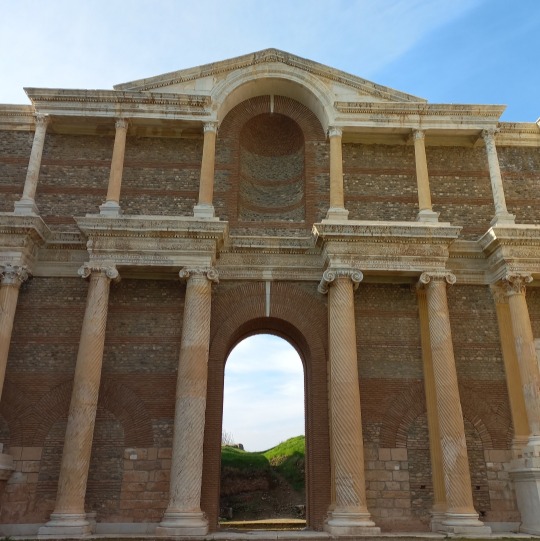
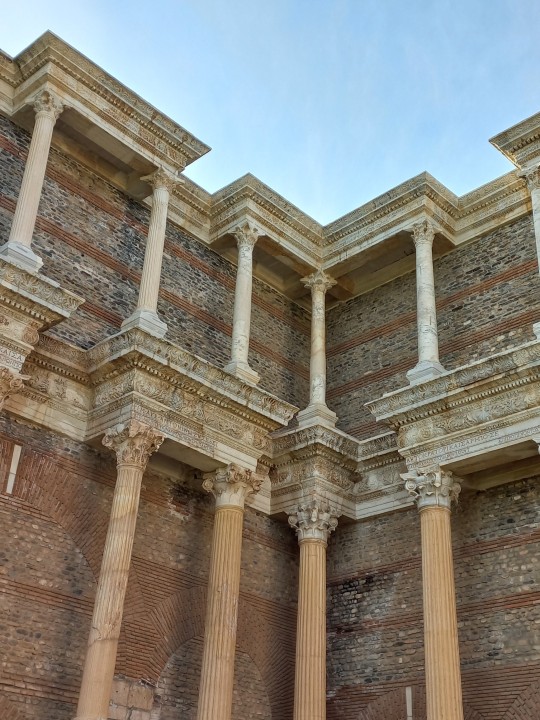
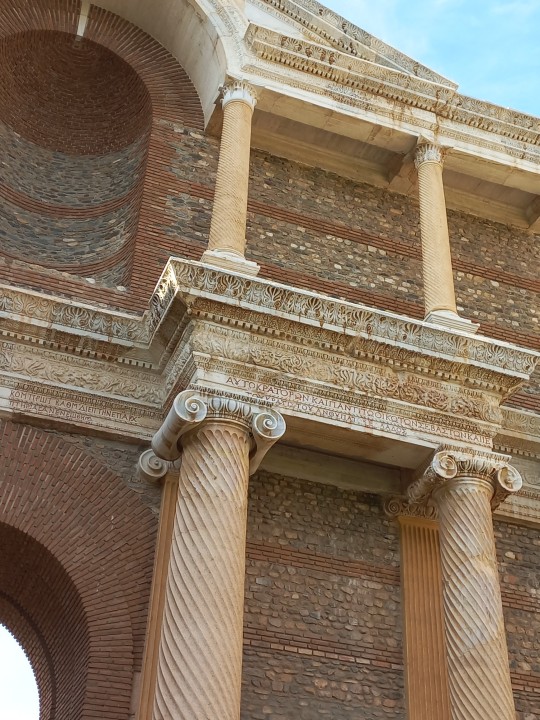
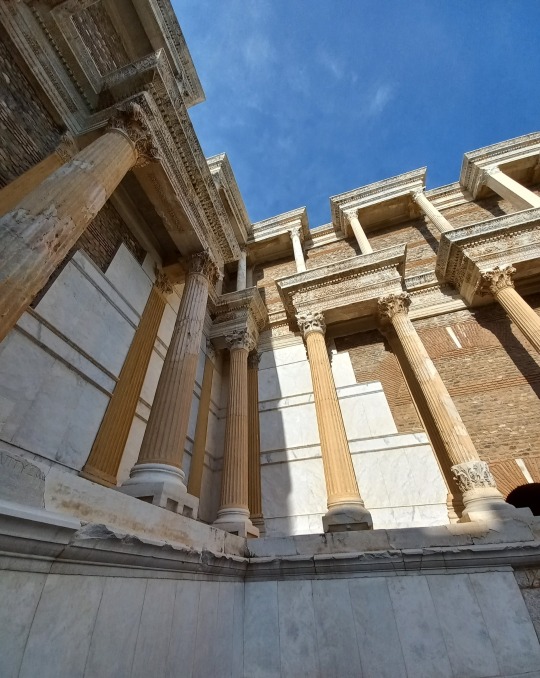
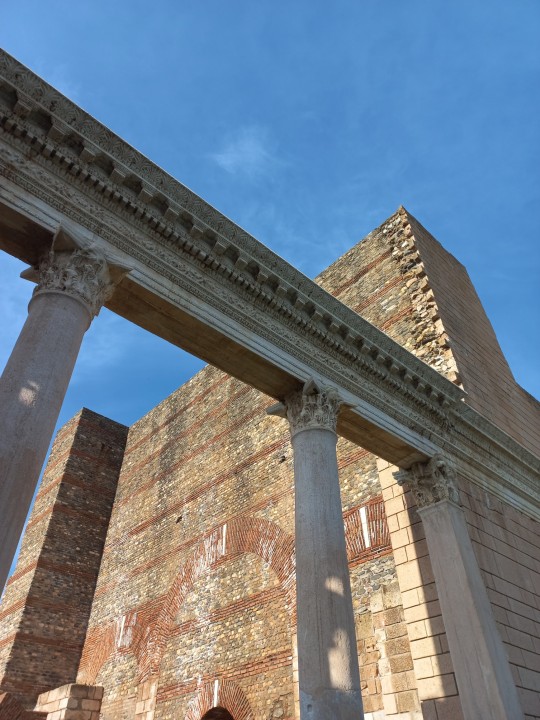
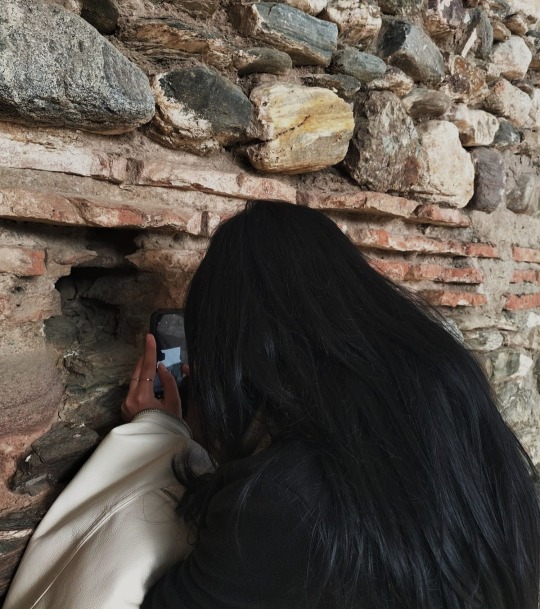

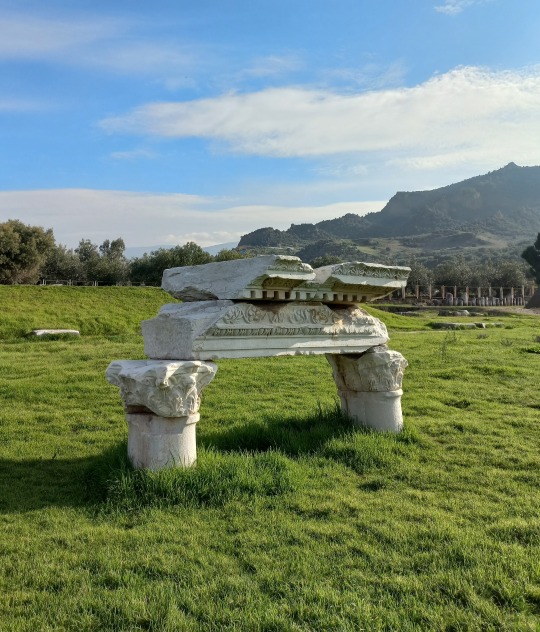
Sat, Jan 12 - I visited the ancient Roman city of Sardes today for the first time. (Information about the city is under this post.) It consisted of the Gymnasium with the remains of many Byzantine shops including restaurants and painting shops, a public pool, tombs, and a Synagogue. It was truly refreshing to see the place overall, but what I adored about the visit was the fact that you could imagine and experience the feeling of what it was like to be living in an ancient city, as it was empty because of the weather conditions. No voices, no noise, no motion, just the smell and the air of this ancient place. (I bet Henry Winter would die for it.) The Temple of Artemis was also close and I went there as well. I'll publish the pictures from the Synagogue and the Temple next if you want to check them out.
Sardis (/ˈsɑːrdɪs/ SAR-diss) or Sardes (/ˈsɑːrdiːs/SAR-de ess; Lydian: 𐤳𐤱𐤠𐤭𐤣, romanized: Sfard; Ancient Greek: Σάρδεις, romanized: Sárdeis; Old Persian: Sparda) was an ancient city best known as the capital of the Lydian Empire. After the fall of the Lydian Empire, it became the capital of the Persian satrapy of Lydia and later a major center of Hellenistic and Byzantine culture. It is now an active archaeological site in modern-day Turkey, in Manisa Province near Sart.
In 334 BC, Sardis was conquered by Alexander the Great. The city was surrendered without a fight, the local satrap having been killed during the Persian defeat at Granikos. After taking power, Alexander restored earlier Lydian customs and laws. For the next two centuries, the city passed between Hellenistic rulers including Antigonus Monophthalmos, Lysimachus, the Seleucids, and the Attalids. It was besieged by Seleucus I in 281 BC and by Antiochus III in 215-213 BC, but neither succeeded at breaching the acropolis, regarded as the strongest fortified place in the world. The city sometimes served as a royal residence, but was itself governed by an assembly.
In this era, the city took on a strong Greek character. The Greek language replaced the Lydian language in most inscriptions, and major buildings were constructed in Greek architectural styles to meet the needs of Greek cultural institutions. These new buildings included a prytaneion, gymnasium, theater, hippodrome, and the massive Temple of Artemis still visible to modern visitors. Jews were settled at Sardis by the Hellenistic king Antiochos III, where they built the Sardis Synagogue and formed a community that continued for much of Late Antiquity.
In 129 BC, Sardis passed to the Romans, under whom it continued its prosperity and political importance as part of the province of Asia. The city received three neocorate honors and was granted ten million sesterces as well as a temporary tax exemption to help it recover after a devastating earthquake in 17 AD.
Sardis had an early Christian community and is referred to in the New Testament as one of the seven churches of Asia. In the Book of Revelation, Jesus refers to Sardians as not finishing what they started, being about image rather than substance.
I take the pictures that are on my blog myself. In case you're interested in this post, I also post/reblog content including travel/cultural pictures, books, book recommendations, analysis, quotes, anything related to movies, series, and girl blog entries.
#sardes#ancient rome#ancient greek#gymnasium#ancient history#ancientmonuments#roman architecture#archeology#blog#travel#history#the secret history#henry winter#synagogue#dark academia#aesthetic#light academia#books#girlblogging#hellenistic#reading#if we were villains
42 notes
·
View notes
Text
As much as I've come to hate Antenor, there is something deeply funny in, what I assume, is people looking at how Antenor talks in the Iliad (and probably other early sources, like one of Bacchylides' poems) and decided that This Man Sus.
So he developed into an outright traitor.
By the Hellenistic era, Lycophron in his Alexandra gives us Antenor as yet another name to add to those who might light the signal torch to lead the Achaean fleet back to shore. (The other two being Sinon, most often, and Helen, in the Aeneid from Deiphobos' undoubtedly biased account.) He also, however, apparently helps open the horse from the outside, to let the warriors inside out.
The two late versions of the war in Dictys and Dares have similar and even more flagrant behaviour.
In Dares, Antenor conspires with several others (after being annoyed Priam refused to sue for peace; the solution is apparently not to force him to sue for peace but to outright betray the whole city and just save themselves). They actively unlock the Scaean gate to let the Achaean army in (no wooden horse in this account). Antenor then also leads Neoptolemos' force up to the palace before he flees.
(Aeneas, who is one of the traitors first helps Hecuba when she and Polyxena first runs into him and hides her in Anchises' house... and then goes and gives her up to the Achaeans to be sacrificed, later. Aeneas is also a traitor in Dictys, and so is Helenus.)
In Dictys, he threatens his own wife to give him the Palladium (which he has agreed previously to hand over to the Achaeans) and gives it over to them. This is the "only" active thing he does, aside from talking for/against the Achaeans to seem as unobjectionable to the rest of the Trojans as possible as necessary.
7 notes
·
View notes
Text
Magical Gemstones: An Abridged Guide
Magical gemstones are a type of talisman made of semiprecious stones —such as hematite, carnelian or amethyst— that were worn set in rings or as pendants and their size ranges from 1.5 cm to 3 cm.These gemstones haven't magical, protective characteristics because of the nature of the gem itself but because the representations of Gods and holy names carved conceded them virtues through holy dynamis: This is, among other things, the inherent power of divine names and/or their representations.
These depictions are normally inverted (negative) This, together with the fact that some of the gems show a certain degree of worn indicates that they were manipulated in some way—probably rubbed or even licked, in order to increase their efficacy—proves that they were not conceived as seals but as amulets or talismans.
A magical gemstone, to be considered as such, should have one or more of the following elements:
An iconographic language generally belonging to syncretic Gods or that combines Gods from different origins.
Charakteres (magical signs. They can be planetary, protective, etc.)
Voces magicae (Words of power and phrases whose formulation and structure may hide secret, sacred names of Gods as well as prayers or incantations dedicated to them, sometimes with the intention of controlling their emanations and daimonēs) and logoi (magical names, permutation of magical names and vocals).
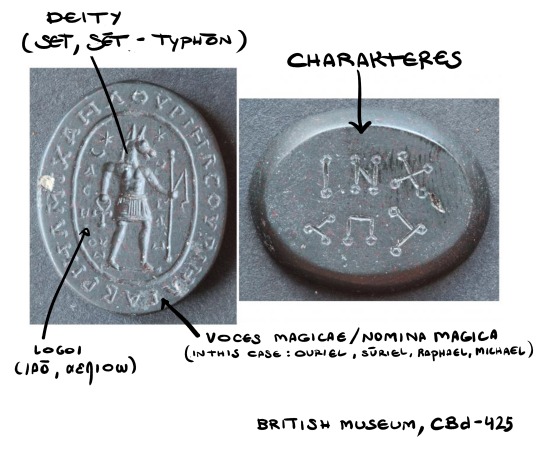
The practice and use of magical voices was transmitted orally across the eastern Mediterranean, but it wasn't until the early 1st century b.c.e. the practice began to be included in written form. The abundance of amulets and gems with magical names and signs are evidence of this change of paradigm.
In addition, elements are usually complemented by two structural features:
The gemstone is engraved on both the obverse and the reverse, sometimes even on the edge.
The inscription appears directly and not in mirror writing.
These magic gemstones, in addition, can be magical gemstones stricto sensu and amuletic gems. The latter differ from the former in:
That the iconographic patterns they contain are explicitly described as belonging to amulets in textual sources such as Posidippus's Lithika
They bear a prophylactic inscription, usually "diaphylasse" (protect me!), "sōzon" (save me!) or "Heis Theos" (One God).
Its production began during the late Hellenistic period, but it was not until the 2nd and 4th centuries c.e. that it reached its apogee. Magical gemstones' imagery demonstrates the diversity and plurality of Greek, Roman, Egyptian, Egyptian, Christian, Gnostic and Jewish representations and ideas from the Mediterranean from the Roman period, as well as the popularity and diversity of magical activities and practices.
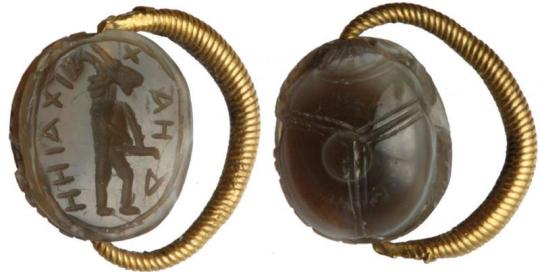
These magic gemstones were rarely used for evil purposes, such as harming someone. Their most common use was to offer protection or solve personal health problems: those showing an ibis tied by an altar and including the command "pésse!" (digest) were used to heal indigestion and other stomach problems; others, depicting a uterus, offered represented a womb, offered protection during childbirth and guaranteed fertility.
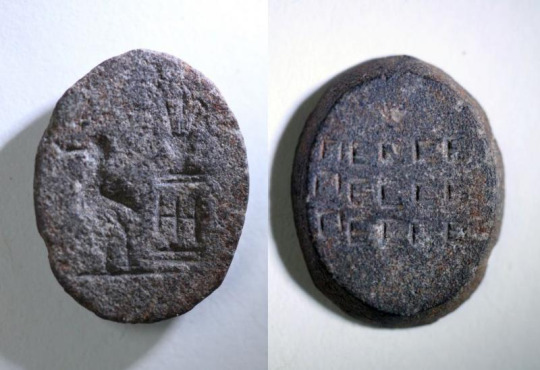

Although most of these magic gemstones were used as jewelry, it is possible that they also had other uses, as part of a ritual to heal a patient or as a physical component for an incantation, such as those with depictions of Harpocrates seated on a lotus the nomina magica Bainchōōōch (Bainchōōōch, Ba of the Shadow, isn't only a vox magica/nomina magica but a God on their own right. PGM aside, Bainchōōōch appears in Pistis Sophia as a triple powered deity that descends onto Jesus, giving him his powers)

An interesting fact is that of the production of magical gemstones during the 17th and 18th centuries of our era. Although the production of these gems continued during the Middle Ages and the Renaissance —irregularly, of course— they reflected the magical and religious reflected the magical and religious practices of their historical context.
This, however, was not the case during the 17th and 18th centuries, where magical gemstones of great quality and sophistication were produced, which not only reproduced the iconographic motifs and logoi of the pre-existing graeco-egyptian magic gemstones, but also introduced new ones. An example of these gems are those with representations of Christ-Osiris or Jesus-Khepri
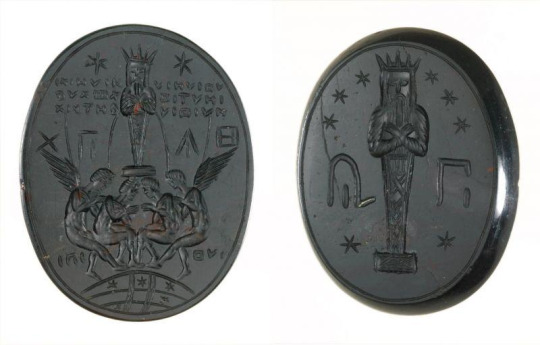
Sources:
Nagy, M. A., (2015) Engineering Ancient Amulets: Magical Gems of the Roman Imperial Period. in D. Boschung and J. Bremmer (eds), The Materiality of Magic (Morphomata 20). Paderborn, 205-240.
Faraone, C. (2018) The Transformation of Greek Amulets in Roman Imperial Times, Filadelfia; University of Pennsylvania Press.
Simone, M., (2005) (Re)Interpreting Magical Gems, Ancient and Modern en Shaked, S., Officina Magica: Essays on the Practice of Magic in Antiquity (IJS Studies in Judaica, vol. 4), Leiden; Brill, 141-170.
Campbell-Bonner Magical Gems Database (http://cbd.mfab.hu)
#magical gemstones#gemstones#PGM#Set#Sutekh#Set-Typhon#Sēt-Typhon#magic#religious syncretism#polytheism#egyptian polytheism#hellenic polytheism#kemetic polytheism#greek magical papyri#Bainchoooch#Thoth#talismans#amulets#talismanic magic
66 notes
·
View notes
Text
So how did we get from this

To this?

Let's talk about the history of Beelzebub!
Beelzebub is strongly associated and indeed often conflated with Baal, a Hellenistic era pagan god worshipped everywhere from the Canaanite city of Ekron to Greece (where he was known as Belus) to Egypt as far back as 1400 BCE. He is first mentioned in the Books of Kings (2 Kings 1:2–3, 6, 16) as Ba'al-zəbûb, meaning "Lord of the Flies" in Hebrew, a possible corruption of "Lord of the High Place" meant to denigrate the deity after he was appropriated and repurposed as a false god, then a demon. Baal worship was extremely difficult for the early Christians to stamp out, so they basically stole other people's mythology and used it as a free idea bucket to fill out the Bible's rogues gallery.
While it's true that in some Ugaritic texts, Baal is depicted as expelling flies and causing sickness, he was still held in high esteem in ancient Canaan and Phoenicia as a powerful deity who controlled the sun, storms, and fertility and who defeated Mot, the god of death and the underworld. The ancient world could get pretty scatological at times! After all, one of Beelzebub's contemporaries, the Egyptian sun god Ra, was often depicted as a dung beetle, then a prominent symbol of rebirth.
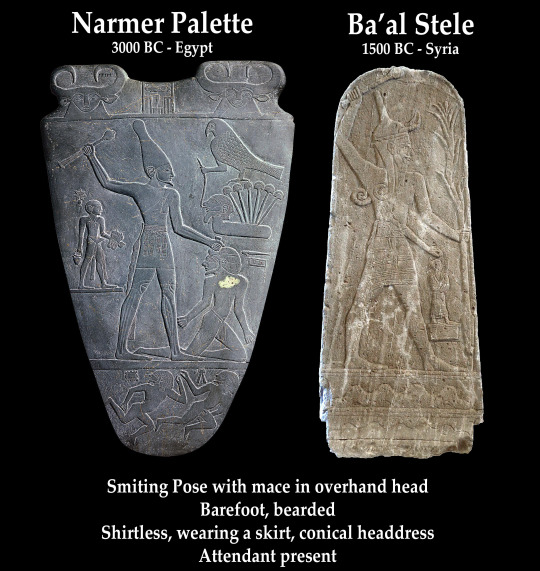
Some scholars think he might have even been the same god! Beelzebub seems to have been the ancient world's go-to demon because the name has been used interchangeably with everyone from Lucifer, Satan, and even Hades in some gnostic texts.
Unfortunately, we don't have much information about Beelzebub's pre-Christian origins other than some iron age ruins in what is now modern day Israel that suggest his temples were decorated with little golden flies, which is pretty neat.
Interestingly, Jesus himself was accused of being a worshipper of Beelzebub multiple times in the New Testament. Maybe the Pharisees were projecting?
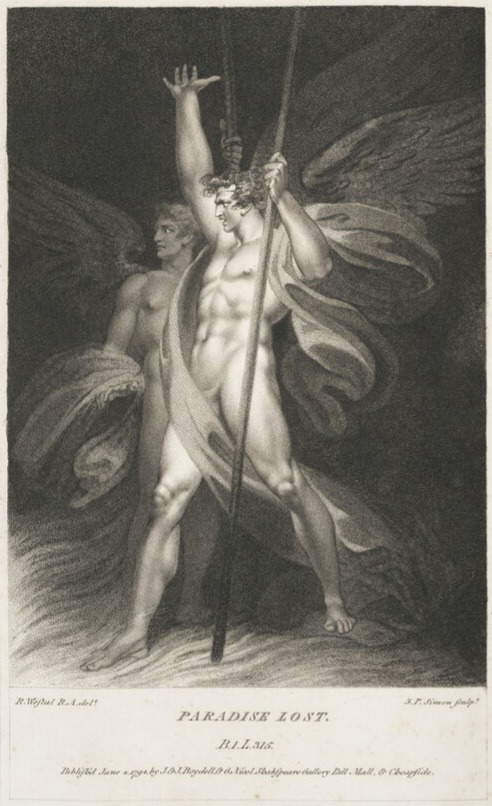
Throughout the Middle Ages, Beelzebub reappeared again in the Lantern of the Light (where he was associated with the sin of envy), De Occulta Philosophia, Princes of Hell, and other demonology texts. 16th-17th Century French Inquisitor Sébastien Michaelis elevated him to the rank of fallen angel in his book The Admirable History of Possession and Conversion of a Penitent Woman: Seduced by a Magician that Made Her to Become a Witch, translated to English in 1613. It was around this time Beelzebub started to become strongly associated with witchcraft. Michaelis should know; he burnt over 14 women accused of being witches!
Unsurprisingly, his name came up repeatedly during the Salem witch trials.
Beelzebub and fellow demons new and old bounced all over different classifications of demons during the 1500s and 1600s. In John Milton's epic poem Paradise Lost, first published in 1667, Beelzebub was part of an unholy trinity consisting of him, Lucifer, and Astaroth. Occultist Johan Weyer decreed that Beelzebub was the Emperor of Hell, having led a successful revolt against the devil. German theologian Peter Binsfield described him as the Prince of Gluttony in his 1589 Treatise on Confessions by Evildoers and Witches. Before that, he was associated with Envy, then Pride.
We even have his personal signature! (At least according to the Grand Grimoir, an anonymous text on black magic of unknown origin)

Beelzebub's physical appearance is even more diverse. He's been depicted as everything from a leopard, a feminine man as tall as a tower, a snake, a calf with a fly's face to...whatever the literal hell this is:
"'dressed like a bee and with two dreadful ears and his hair painted in all colors with a dragon's tail"


Jacques Albin Simon Collin de Plancy (1793 – 1881)'s Dictionnaire infernal was among the first to depict Beelzebub literally as a fly. No duck feet, no lion's mane. Just a fly.

Still better than this.
As Plancy was a skeptic influenced by Voltaire, the book was first intended as a folklore compilation but was later modified to fit with Roman Catholic theology after he converted, much to the consternation of his admirers. Many of his lurid illustrations later appeared in S. L. MacGregor Mathers's edition of The Lesser Key of Solomon...for better or for worse.

Put Adrammelech in Helluva Boss you cowards.
So basically, Beelzebub has been a public domain character since before King Tut was laid in his golden sarcophagus, and people have been just making shit up about him for millennia. What's your favorite depictation of Beelzebub? This is mine:
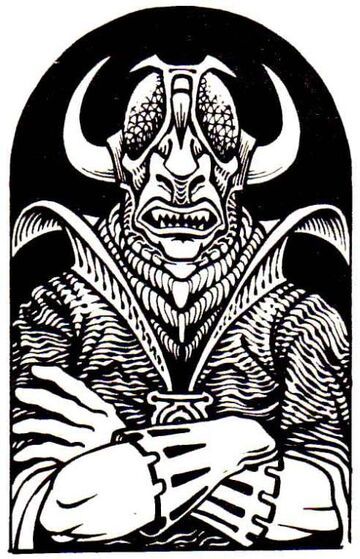
Nothing beats 2nd Edition Dungeons & Dragons artwork.
#helluva boss#queen bee#beelzebub#character design#meta#demonology#history#mythology#long post#vivziepop#dandelion watches hellaverse#religion
42 notes
·
View notes
Note
Was keeping the war conquest machine important for Macedon as a country or for Alexander's new empire in an economic sense? As in, if Alexander stopped conquering, the whole thing would fall apart in a financial-economic perspective?
Alexander's War-Conquest Machine
If anything, I think part of what tanked Alexander's empire at his death was the fact he hadn't quit conquering long enough to actually consolidate anything.
In ancient economics (which were pretty basic, relatively), short-term war (when one is winning) is good for the economy. It brings in resources in the form of booty. It also tends to favor innovation (over stagnation). The reason is that innovation is required in order to win.
So for instance, Philip hired engineers for his army (artillery), but their inventions of torsion catapults and ballistae had a lot of secondary uses. Also, his success in war funneled enough money back into the country to create a visible middle class.
But when wars drag on-and-on-and-on-and-on, even when winning, the end result is a mixture of sapping the population and not allowing consolidation. Philip's wars began to verge on that, and Alexander only extended the problem. The Macedonian (especially male) population plummeted by the early Hellenistic era. This is something Brian Bosworth wrote about. While his conclusions were, imo, overly modern, and strident ("a never-ending dance of death"), the observation itself is true enough.
There's also simply the problem of running the areas one has conquered. How much damage to infrastructure did the conquest cause? By infrastructure here, I mean both physical AND economic. Alas, our ancient sources rarely focus on these matters. Conquest was glorious. Administration was boring. I fear the modern news media's fixation on chaos (political and social) exacerbates our addiction to it. But people really want to live in UNinteresting times! (Why ancient Ur III, a hugely successful Sumerian dynastic period, is also pretty boring to lecture about.)
Anyway, Alexander's failure to fully secure his conquests is one of the problems with his reign. Partly, he just didn't live long enough. But he also had itchy feet and, I think, was only beginning to appreciate the need for stabilizing things such as trade and competent administration in the latter years of his life.
#asks#alexander the great#philip II of macedon#philip of macedon#ancient macedonia#ancient economics#ancient conquest#ancient greece#ancient persia
20 notes
·
View notes
Text
Trying to design period accurate costumes for Antigone for my Drama A level.
WHY DOES EVERY REFERENCE BOOK TREAT ANCIENT GREECE LIKE ONE COHESIVE WHOLE!?!?!!?!?!?!
Like, I know there's got to be a difference between what they would have worn in the Mycenaean age and what Sophocles-era classical greeks would have worn and Hellenistic Greeks would have worn and so on and so forth. Human beings won't be wearing the same thing without variation for over a thousand years. I know that from my other forays into fashion history.
Yet, nothing I can find is telling me about this difference, and I'll get the marks whether I can communicate the singularity of 400BCE fashions or not, but I want to KNOW so that the costumes can be RIGHT, rather than just tossing off the popular Greek silhouette.
The examiner probably won't care if there are archaic elements in there, but I would really rather do it right than counting on the examiner not being an expert in Classical Greek fashion history.
So, um, if anyone knows about the identifying features of what would have been worn by Athenian or Theban Greeks in the early 400s BCE, please please please help a very lost and confused child.
#fashion history#ancient history#ancient greece#homeric greece#archaic greece#classical greece#hellenistic greece#antigone#drama#all my books are just like oh yes here is this Ancient Greek and this is what their clothes are called#yes#but can you also tell me how it differs to what other ancient greeks wore?#no#I know nothing#and I know that I know nothing and its frustrating#please#if you know anything#fabrics#dyes#jewellry#hair#armour#literally anything#I am so lost#please help a poor lost child who just wants to KNOW
10 notes
·
View notes
Text
Alexander the Great, born in 356 BCE in Macedonia, was one of history’s greatest military leaders. He became king after his father, King Philip II, was assassinated. By his early thirties, he had created one of the largest empires in history, stretching from Greece to Egypt and into northwest India. Known for his tactical genius, Alexander never lost a battle. His conquests spread Greek culture, leading to the Hellenistic era, a fusion of Greek and Eastern cultures. He died in 323 BCE in Babylon, but his legacy as a visionary leader endures.


2 notes
·
View notes
Note
Hi! Just saw that you consider yourself a Hellenistic Pagan - that’s so interesting!! Wasn’t aware this is still being practiced since Constantine and the early days of Byzantium. Would love to learn more if you’re up to talking about this?
Like, do you worship all twelve Olympians or just a subset of them? And what are festivals/rituals like, singing hymns to Dionysius and weaving wreaths and drinking wine under the full moon at the beginning of the year, or are practices from the ancient religion like sacrificing bulls still being done? Or are you perhaps an Orphic or Pythagorean and abstain from broad beans?
'στώ πολύ ❤️
Nothing so formal, I’m afraid :) it’s just that in moments of stress, they’re the deities that feel most meaningful to me to appeal to and to whom I feel the most connection. I’ve loved the Olympians since I was 9 years old and I’ve found Christianity (except perhaps for the actual message of actual possibly historical Jesus, which modern Christianity by and large has little to do with) to be distasteful and uncomfortable for me personally for a variety of reasons since early childhood (and possibly since my baptism, apparently as an infant I ripped the gold cross necklace off my neck during the baptism, lol. Probably just because infants like to grab and pull on things and gold is very soft, but I’m certainly proud of my infant self for doing so and it certainly set the tone for my relationship with Christianity :) ).
Anyway, the Hellenistic pantheon was worshipped from at least the Bronze Age until roughly 400 CE. So at least as long or longer than Christianity has existed. I consider that a pretty field-tested form of faith by the length of time it persisted alone. I don’t claim to worship them as a priest or priestess of that era would. More as I imagine and read of laymen of those years thinking of them and appealing to them. But since the conception of their role in the universe and the relationship of such figures with humanity is so different from the Christian formal and informal relationship with God (speaking in overly general terms, since I’m hardly going to write a religious academic essay that takes all variations of Christianity, its sects, and its believers into account as a reply) it’s simply easier to describe myself as an atheist, because more often than not when people inquire into religious views they effectively mean “and how they interact with the public sphere.”
I don’t think faith should ever have anything to do with the governing or organization of the public sphere. I don’t think it should be anything but a personal comfort and inspiration via its stories and history. Whether or not it’s factually true is entirely beside the point, as I feel about the Hellenistic pantheon. Religion certainly shouldn’t have any impact on laws or how society treats individuals. It shouldn’t get exceptions carved out for its organizations in a way that impacts those who don’t share that faith.
Also, one aspect of holding this personal belief is that I prefer to align myself emotionally with a pantheon that is completely divorced from the current discourse, including atheism as a group of any kind, in order to keep a sort of nominally detached perspective mostly on the societal impact of religion but also on the dogma of some subsections of atheists who are also dismissive of the meaningfulness of some sort of faith as comfort and inspiration for individuals.
18 notes
·
View notes
Text


Rare Coins and Treasures Discovered at Greece’s Ancient City of Tenea
Archaeologists in Greece discovered a hoard of rare ancient coins and other treasures at the ruins of Tenea, near Corinth, a city that was built by Trojan prisoners of war.
The Ministry of Culture announced on Tuesday that the recent excavation unearthed 29 silver ancient Greek coins dating from the late 6th century.
Several are among the rarest and most historic coins of ancient Greece, the ministry says.
Rare silver coins unearthed at Tenea
They include three staters of Elis minted at Olympia during different Olympic Games, staters of Aegina with a land instead of a sea turtle, staters of Stymphalos, Argos and Opuntia Lokron, as well as staters of Thebes from the 5th century BC depicting Hercules suffocating two snakes with his hands.
The stater, as a Greek silver currency, first as ingots, and later as coins, circulated from the 8th century BC to AD 50. The earliest known stamped stater (having the mark of some authority in the form of a picture or words) is an electrum turtle coin, struck at Aegina that dates to about 650 BC.
The treasure is linked to the finds of cult use (female and animal figurines, miniature vases and others) that were identified last year and continued to be identified this year, giving a clear ritual character to the areas that are revealed the announcement says.
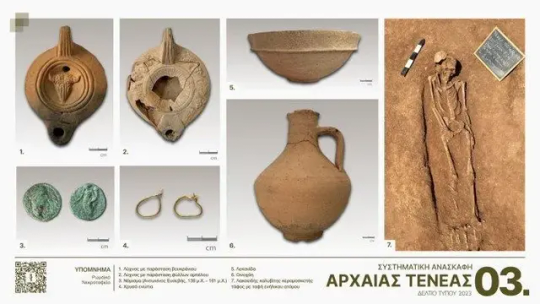

Other stunning discoveries
The excavations at Tenea also revealed a section of Hadrian’s aqueduct, determining the course of one of the largest hydraulic works of the 2nd century. A.D. in Greece.
Also, part of the prehistoric settlement of Tenea, dating to the Early Bronze Age II (2,600 – 2,300 BC), was identified and excavated, confirming the area’s habitation before the fall of Troy.
In addition, a rich building complex from the late Archaic times to the Hellenistic times was revealed, with individual areas of cult use between them and three extremely well-maintained tanks, one of them with a descending-ascending scale.
The new excavations brought to light dozens of ancient pots and figurines.


The ancient city of Tenea in Greece discovered in 2018
According to Greek mythology, Tenea was established by Trojan prisoners of war who were granted permission by King Agamemnon to build their own settlement after the Trojan War.
The city’s location, roughly 15 kilometers (9.3 mi) southeast of Corinth and 20 kilometers (12 mi) northeast of Mycenae, made it an important crossroads for trade and communication.


In 2018, a team of Greek archaeologists led by Eleni Korka made a remarkable discovery: the remains of ancient Tenea, previously thought to be a mythical city.
The first excavations revealed a vast necropolis, or cemetery, dating back to the 4th century BC to the Roman era. Among the unearthed artifacts were jewelry, coins, and pottery shards, providing valuable insights into the city’s history and culture.
By Tasos Kokkinidis.

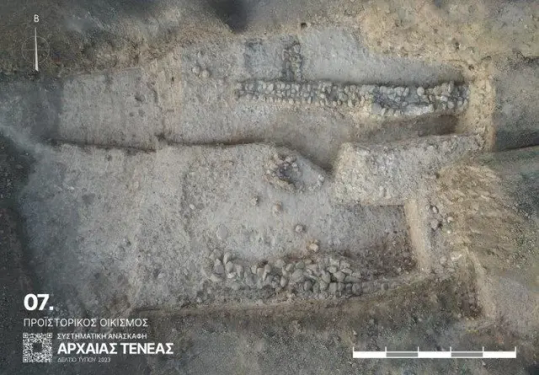
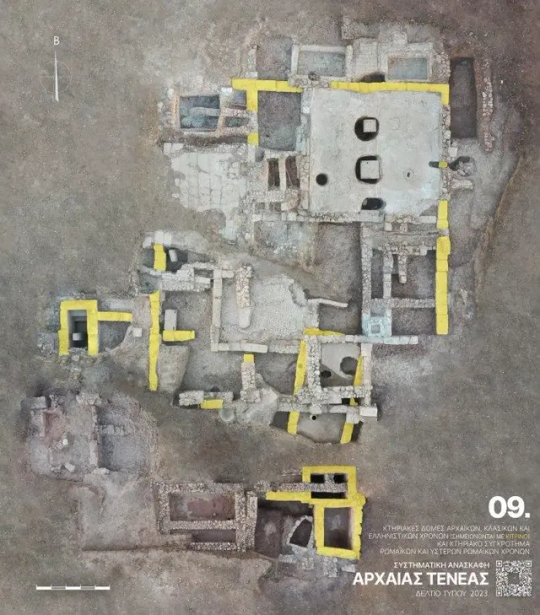
#Rare Coins and Treasures Discovered at Greece’s Ancient City of Tenea#Greece’s Ancient City of Tenea#silver#silver coins#ancient coins#ancient artifacts#archeology#archeolgst#history#history news#ancient history#ancient culture#ancient civilizations#ancient greece#greek history#greek art
52 notes
·
View notes